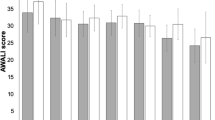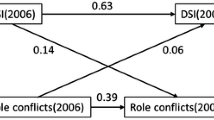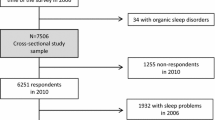Abstract
Purpose
A growing number of longitudinal studies report associations between adverse psychosocial factors at work and sleep problems. However, the evidence regarding the direction of these associations and the effects of changes in exposure across time is limited. This study examined the plausibility of normal, reverse, and reciprocal associations between ten psychosocial factors at work and sleep problems. In addition, we analyzed if reduced exposure across time had the anticipated result of reducing the risk of sleep problems.
Methods
Randomly drawn from the general working-age population, the cohort comprised respondents with an active employee relationship in 2009 and 2013 (N = 5760). Exposures and outcome were measured on two occasions separated by 4 years. We computed several sex-stratified logistic regression models with adjustments for various plausible confounders.
Results
We found support for the commonly hypothesized unidirectional forward associations between psychosocial factors at work and sleep problems among women only. Among men, psychosocial stressors at work and sleep problems were reciprocally and reversely related. Nevertheless, reduced exposure levels across time pertaining to effort–reward imbalance (OR = 0.36; 95% CI = 0.19–0.69) and lack of social support (OR = 0.55; 95% CI = 0.32–0.93) among men, and work–family imbalance (OR = 0.26; 95% CI = 0.15–0.46) among women were associated with a robust significant lower risk of sleep problems compared to those in the stable high exposure groups.
Conclusions
The study results suggest that preventive measures targeting effort–reward imbalance and lack of social support among men, and work–family imbalance among women, might contribute to reduce the risk of troubled sleep among employees.
Similar content being viewed by others
References
Åkerstedt T (2003) Shift work and disturbed sleep/wakefulness. Occup Med 53(2):89–94
Åkerstedt T (2006) Psychosocial stress and impaired sleep. Scand J Work Environ Health 32(6):493–501
Åkerstedt T, Fredlund P, Gillberg M, Jansson B (2002) Work load and work hours in relation to disturbed sleep and fatigue in a large representative sample. J Psychosom Res 53(1):585–588
Åkerstedt T, Knutsson A, Westerholm P, Theorell T, Alfredsson L, Kecklund G (2004) Mental fatigue, work and sleep. J Psychosom Res 57(5):427–433
Åkerstedt T, Nordin M, Alfredsson L, Westerholm P, Kecklund G (2012) Predicting changes in sleep complaints from baseline values and changes in work demands, work control, and work preoccupation—the WOLF-project. Sleep Med 13(1):73–80
Åkerstedt T et al (2015) Work and sleep-a prospective study of psychosocial work factors, physical work factors, and work scheduling. Sleep 38(7):1129–1136
Boot C (2015) Work characteristics and health: how to analyze change. Scand J Work Environ Health 41(6):509
De Lange AH, Taris TW, Kompier MA, Houtman IL, Bongers PM (2005) Different mechanisms to explain the reversed effects of mental health on work characteristics. Scand J Work Environ Health 31(1):3–14
De Lange AH et al (2009) A hard day’s night: a longitudinal study on the relationships among job demands and job control, sleep quality and fatigue. J Sleep Res 18(3):374–383
Elo AL, Skogstad A, Dallner M, Gamberale F, Hottinen V, Knardahl S (2000) User’s guide for the QPSNordic: General Nordic Questionnaire for psychological and social factors at work. Nordic Council of Ministers, Copenhagen. TemaNord 2000:603
Flier JS, Underhill LH, McEwen BS (1998) Protective and damaging effects of stress mediators. N Engl J Med 338(3):171–179
Hanson LLM, Åkerstedt T, Näswall K, Leineweber C, Theorell T, Westerlund H (2011) Cross-lagged relationships between workplace demands, control, support, and sleep problems. Sleep 34(10):1403
Karasek RA Jr (1979) Job demands, job decision latitude, and mental strain: implications for job redesign. Admin Sci Quart 24(2):285–308
Kompier M (2003) Job design and well-being. Handb Work Health Psychol 2:429–454
LeBlanc M, Mérette C, Savard J, Ivers H, Baillargeon L, Morin CM (2009) Incidence and risk factors of insomnia in a population-based sample. Sleep 32(8):1027–1037
Linton SJ et al (2015) The effect of the work environment on future sleep disturbances: a systematic review. Sleep Med Rev 23:10–19
Luckhaupt SE, Tak S, Calvert GM (2010) The prevalence of short sleep duration by industry and occupation in the National Health Interview Survey. Sleep 33(2):149–159
Minkel JD et al (2012) Sleep quality and neural circuit function supporting emotion regulation. Biol Mood Anxiety Disord 2(1):1
Moffitt PF, Kalucy E, Kalucy R, Baum F, Cooke R (1991) Sleep difficulties, pain and other correlates. J Intern Med 230(3):245–249
Ohayon MM (2002) Epidemiology of insomnia: what we know and what we still need to learn. Sleep Med Rev 6(2):97–111
Ota A et al (2009) Psychosocial job characteristics and insomnia: a prospective cohort study using the Demand-Control-Support (DCS) and Effort-Reward Imbalance (ERI) job stress models. Sleep Med 10(10):1112–1117
Podsakoff PM, MacKenzie SB, Lee J-Y, Podsakoff NP (2003) Common method biases in behavioral research: a critical review of the literature and recommended remedies. J Appl Psychol 88(5):879
Rugulies R, Norborg M, Sørensen TS, Knudsen LE, Burr H (2009) Effort–reward imbalance at work and risk of sleep disturbances. Cross-sectional and prospective results from the Danish Work Environment Cohort Study. J Psychosom Res 66(1):75–83
Sabanayagam C, Shankar A (2011) The association between active smoking, smokeless tobacco, second-hand smoke exposure and insufficient sleep. Sleep Med 12(1):7–11
Sekine M, Chandola T, Martikainen P, Marmot M, Kagamimori S (2006) Work and family characteristics as determinants of socioeconomic and sex inequalities in sleep: the Japanese Civil Servants Study. Sleep N Y Westchest 29(2):206
Siegrist J et al (2004) The measurement of effort–reward imbalance at work: European comparisons. Soc Sci Med 58(8):1483–1499
Statistics Norway (2010) Samordnet levekårsundersøkelse 2009-Tverrsnitt: Arbeidsmiljø. Report in Norwegian Statistics Norway Oslo, Tema
Van Dongen HPA, Maislin G, Mullington JM, Dinges DF (2003) The cumulative cost of additional wakefulness: dose-response effects on neurobehavioral functions and sleep physiology from chronic sleep restriction and total sleep deprivation. Sleep N Y Westchest 26(2):117–129
van Hooff ML, Taris TW (2014) Let’s study how worker health affects the psychosocial work environment. Scand J Work Environ Health 40(5):437
Van Laethem M, Beckers DG, Kompier MA, Dijksterhuis A, Geurts SA (2013) Psychosocial work characteristics and sleep quality: a systematic review of longitudinal and intervention research. Scand J Work Environ Health 39(6):535–549. doi:10.5271/sjweh.3376
Van Reeth O, Weibel L, Spiegel K, Leproult R, Dugovic C, Maccari S (2000) Physiology of sleep (review)–interactions between stress and sleep: from basic research to clinical situations. Sleep Med Rev 4(2):201–219
Vleeshouwers J, Knardahl S, Christensen J (2015) Effects of psychological and social work factors on self-reported sleep disturbance and difficulties initiating sleep. Sleep 39(4):833–846
Zhang B, Wing Y (2006) Sex differences in insomnia: a meta-analysis. Sleep N Y Westchest 29(1):85
Author information
Authors and Affiliations
Corresponding author
Ethics declarations
Conflict of interest
The authors declare that they have no conflict of interest.
Rights and permissions
About this article
Cite this article
Johannessen, H.A., Sterud, T. Psychosocial factors at work and sleep problems: a longitudinal study of the general working population in Norway. Int Arch Occup Environ Health 90, 597–608 (2017). https://doi.org/10.1007/s00420-017-1222-2
Received:
Accepted:
Published:
Issue Date:
DOI: https://doi.org/10.1007/s00420-017-1222-2




